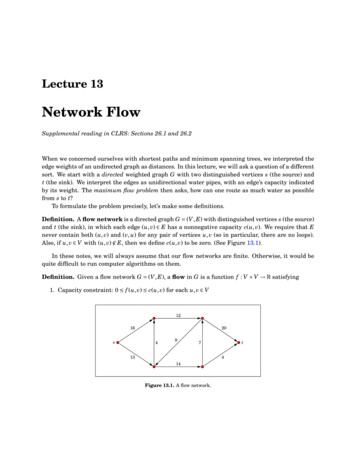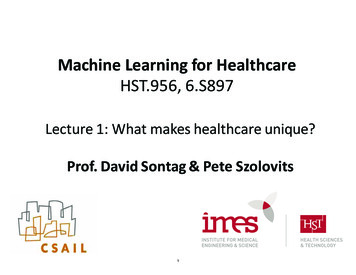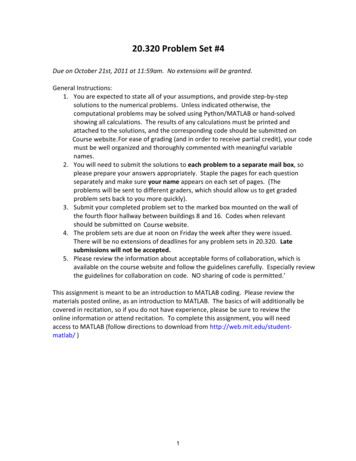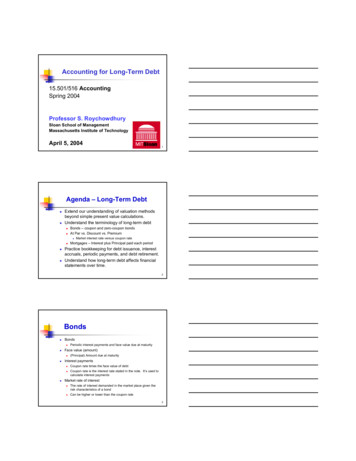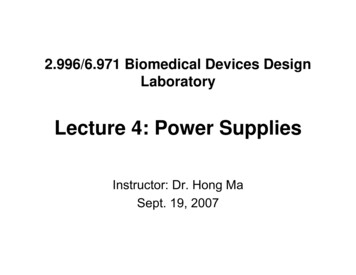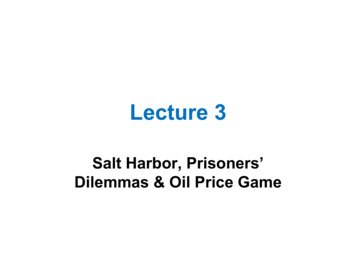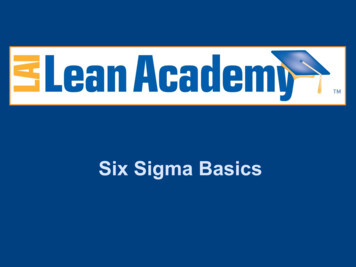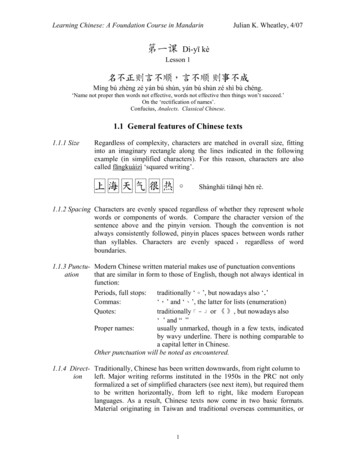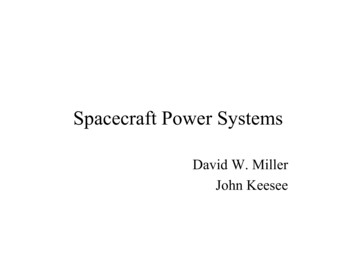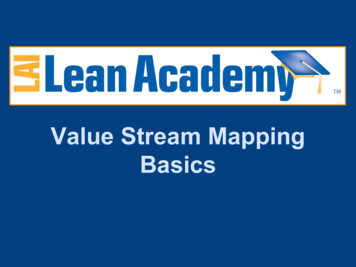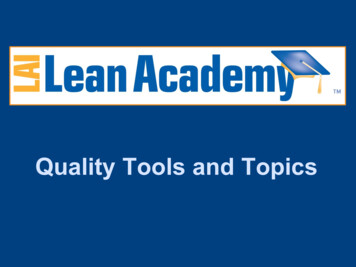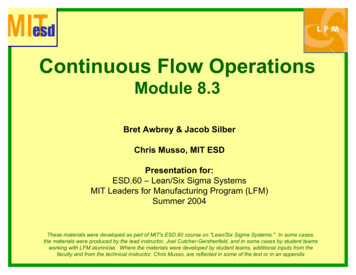
Transcription
Continuous Flow OperationsModule 8.3Bret Awbrey & Jacob SilberChris Musso, MIT ESDPresentation for:ESD.60 – Lean/Six Sigma SystemsMIT Leaders for Manufacturing Program (LFM)Summer 2004These materials were developed as part of MIT's ESD.60 course on "Lean/Six Sigma Systems." In some cases,the materials were produced by the lead instructor, Joel Cutcher-Gershenfeld, and in some cases by student teamsworking with LFM alumni/ae. Where the materials were developed by student teams, additional inputs from thefaculty and from the technical instructor, Chris Musso, are reflected in some of the text or in an appendix
Overview¾ Session Design (20-30 min.)¾ Learning Objectives¾ What is a continuous flowoperation?¾ What considerations arecritical to the business?¾ How do lean principles applyto a continuous flowoperation?¾ Part I: Introduction and LearningObjectives (1-2 min.)¾ Part II: Key Concept or PrincipleDefined and Explained (3-5 min.)¾ Part III: Exercise or ActivityBased on Field Data thatIllustrates the Concept orPrinciple (7-10 min.)¾ Part IV: Common “Disconnects,”Relevant Measures of Success,and Potential ActionAssignment(s) to Apply LessonsLearned (7-10 min.)¾ Part V: Evaluation andConcluding Comments (2-3 min.) Bret Awbrey & Jacob Silber – ESD.60 Lean/Six Sigma Systems, LFM, MITPart I: IntroductionPart II: ConceptsPart III: Application6/9/04 -- 2Part IV: DisconnectsPart V: Conclusion
Continuous Flow Operations¾ The ability to maintain steady state conditions in flowand concentration through the modules of the system1¾ Examples include:¾ chemical synthesis¾ Some food manufacturing (chocolate, beer)¾ water processing¾ energy generation¾ information technology Bret Awbrey & Jacob Silber – ESD.60 Lean/Six Sigma Systems, LFM, MITPart I: IntroductionPart II: ConceptsPart III: Application6/9/04 -- 3Part IV: DisconnectsPart V: Conclusion
Continuous Flow – Defining Factors2,3¾¾¾¾¾¾¾High product volumeSpecial purpose equipment (low flexibility)Uninterrupted product flowFew schedule changesLow number of standardized productsLow variable cost (up to capacity level)Low labor skill (operators) during regular operations Bret Awbrey & Jacob Silber – ESD.60 Lean/Six Sigma Systems, LFM, MITPart I: IntroductionPart II: ConceptsPart III: Application6/9/04 -- 4Part IV: DisconnectsPart V: Conclusion
Continuous Flow – Critical Factors¾¾¾¾¾¾¾¾Capital intensive (start-up)Storage of in-process and finished goodsMaterial waste or lossMaintenance costsFluctuations in demandSupply of finished goods is usually constantProducts often become commoditiesEconomies of scale (usually bigger is better) Bret Awbrey & Jacob Silber – ESD.60 Lean/Six Sigma Systems, LFM, MITPart I: IntroductionPart II: ConceptsPart III: Application6/9/04 -- 5Part IV: DisconnectsPart V: Conclusion
Continuous Flow – Lean Parameters¾ Initial engineering design is critical¾ Change in production quantity¾ Introducing additional equipment¾¾¾¾¾In-line sensingPreventative MaintenanceOverall Equipment EffectivenessEqualization of Takt times (Line balance)Accurate forecasting of demand Bret Awbrey & Jacob Silber – ESD.60 Lean/Six Sigma Systems, LFM, MITPart I: IntroductionPart II: ConceptsPart III: Application6/9/04 -- 7Part IV: DisconnectsPart V: Conclusion
Initial design and sensing concerns¾ Initial design should take into account:¾ Ease of maintenance¾ Ability to expand/reduce production¾ Changing input costs¾ Preventative maintenance¾ Sensing:¾ Can evaluate qualitative factors with quantitative information¾ Helps drive process improvement¾ Can detect equipment problems in un-viewable areas Bret Awbrey & Jacob Silber – ESD.60 Lean/Six Sigma Systems, LFM, MITPart I: IntroductionPart II: ConceptsPart III: Application6/9/04 -- 8Part IV: DisconnectsPart V: Conclusion
Chocolate Production FlowMixing 200 g/mRefiningConching 50 g/m100 g/mLiquid CoatingsStd. & Inspection75 g/m75 g/mBulk 5 t/dMixing Tempering 25 g/mDepositing 25 g/mMoulding 25 g/m Bret Awbrey & Jacob Silber – ESD.60 Lean/Six Sigma Systems, LFM, MITPart I: IntroductionPart II: ConceptsPart III: Application6/9/04 -- 9Part IV: DisconnectsPart V: Conclusion
Overall Equipment Effectiveness¾ OEE Availability x Performance Rate x Quality Rate¾ between capability and real output¾ Options:¾ Inspect equipment for flaws, repair¾ Test equipment¾ Check original design document (original specifications)¾ Add inline tempering/conching unit (additional capacity)Availability (operating time/net available time) XPerformance ((ideal cycle time x total parts run)/operating time) XQuality ((total parts run - total defects)/total parts run) Bret Awbrey & Jacob Silber – ESD.60 Lean/Six Sigma Systems, LFM, MITPart I: IntroductionPart II: ConceptsPart III: Application6/9/04 -- 11Part IV: DisconnectsPart V: Conclusion
Disconnects¾ Technical Factors¾ Social Factors¾ Supply is typicallyconstant, hard to changein a Brownfield operation¾ Initial design might notaccount for laterimprovements¾ Maintenance moredifficult (downtimes maynot exist)¾ High cost of productionstep-function¾ Demand is typically variable¾ Operators typically have littleinput (chemical reactors,generators), so harder to getcontinuous improvement¾ High competition for lowestcost, commodity game Bret Awbrey & Jacob Silber – ESD.60 Lean/Six Sigma Systems, LFM, MITPart I: IntroductionPart II: ConceptsPart III: Application6/9/04 -- 12Part IV: DisconnectsPart V: Conclusion
Measurables¾ OEE Availability x Performance Rate x Quality Rate¾ Improved forecasting of demand can lead to morenarrow control limits (σ)¾ Statistical data from sensing to improve quality Bret Awbrey & Jacob Silber – ESD.60 Lean/Six Sigma Systems, LFM, MITPart I: IntroductionPart II: ConceptsPart III: Application6/9/04 -- 13Part IV: DisconnectsPart V: Conclusion
Concluding Comments¾ Typical situations are Brownfield operations where initial designis sub-optimal. In these cases capital improvements may bedifficult based on earlier designs.¾ Cost of changing capacity can also be high because of similarBrownfield considerations. (Ex. Power plant)¾ Important tools include the OEE for establishing line balanceand reducing bottlenecks. Bret Awbrey & Jacob Silber – ESD.60 Lean/Six Sigma Systems, LFM, MITPart I: IntroductionPart II: ConceptsPart III: Application6/9/04 -- 14Part IV: DisconnectsPart V: Conclusion
Appendix: Instructor’s Comments and ClassDiscussion¾ Key issue in continuous flow industries: balancingsupply and demand¾ Economies of scale lead to continuous, large scaleproduction—often more than market demands¾ Apparent economies become disabilities¾ Process industries often use financial instruments tomake up for inability to scale to demand¾ Socio-tech teams are often used instead of leanteams, since there is more meeting time and globalfocus on plant is required¾ Scope of OEE is important: it can be for anindividual machine, the bottleneck operation, anproduction operation or line, or an entire plant Bret Awbrey & Jacob Silber – ESD.60 Lean/Six Sigma Systems, LFM, MIT6/9/04 -- 15
Appendix: Instructor’s GuideSlide TimeTopicAdditional Talking Points1-22-3 minIntroduction, overview andlearning objectives What is a CF process? Business Applications? Leanapplications in CF environment?32 minKey Concepts - ContinuousFlow Operations A perfectly lean discrete operation could be considered“continuous.” However, this is not subject of this SPL.4-85-8 minKey Concepts (con) - Definingfactors, Critical factors, Graph,and lean parameters. The characteristics (defining factors) Example of capital expenses are a plant being run even though itis losing money because it costs more money to shut it down. Maintenance costs - sometimes as high as 10% of sales Commoditization of product - price set by market, lowest costprovider is winner For graph (slide 6) - Area under curves match, but costs ofstraight supply are in not meeting demand (losing customers) andexcess finished goods inventory. Ideally the will match and anysystem that is designed to be responsive over a shorter andshorter piece of time will be more effective.9-107- 10 minExercises/Activities - Chocolatefactory Look at system flow and its constraints. If we are looking atdifferent objectives, then the limiting factor will change. Thisexample looks at maximum available for depositing and moulding.111-2 minOverall EquipmentEffectiveness Basic method for balancing line flow. As a consultant you wouldfirst look at this.125-7 minDisconnects Look for personal examples either from audience or from yourown experiences132-3 minMeasurables OEE14 Leanhappensat design.Bret Awbrey& Jacob Silbercomments– ESD.60 Lean/Six Sigma Systems,LFM,MIT1-2 minConcludingPart I: IntroductionPart II: ConceptsPart III: ApplicationDesign responsivenessto demand.6/9/04 -- 16Part IV: DisconnectsPart V: Conclusion
References¾¾¾¾¾¾¾¾Reference 1 - http://weather.nmsu.edu/Teaching Material/SOIL698/Student Material/AutoAnalyzer/Flow.htmlReference 2 – Adam, Everett E., Ebert, Ronald J. Production and Operations Management. Englewood Cliffs, NJ. PrenticeHall. 1978.Reference 3 - /Reference 4 - rd/overall.htmFigure 1 - /diagram story of choc.gifImage 1 - http://www.eia.doe.gov/kids/images/Amoco.jpgImage 2 - http://www.waega.de/6thOct3.jpgImage 3 - http://www.titanicbrewery.com/images/brewery.jpg Bret Awbrey & Jacob Silber – ESD.60 Lean/Six Sigma Systems, LFM, MIT6/9/04 -- 17
Continuous Flow Operations Module 8.3 Bret Awbrey & Jacob Silber Chris Musso, MIT ESD Presentation for: Summer 2004 i ESD.60 – Lean/Six Sigma Systems MIT Leaders for Manufacturing Program (LFM) These materials were developed as part of MIT's ESD.60 course on "Lean/Six Sigma Systems." In some cases, the materials were produced by the lead instructor, Joel Cutcher
